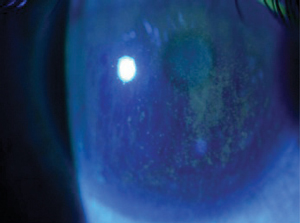 |
Patients who smoke or have a high BMI are more likely to have dry eye. Photo: Jennifer Harthan, OD. Click image to enlarge. |
Researchers recently found that smokers and individuals with a high BMI showed significantly lower lipid layer grades and tear meniscus height scores compared with controls. They noted that their assessment of tear film parameters supports the findings of previous studies that implicate smoking and high BMI as risk factors for dry eye.
The study included 30 males with a high BMI (> 25 kg/m2; 24.4 years), 30 smokers (25.1 years) and 30 healthy subjects (22.2 years). Each subject completed the OSDI and underwent assessment of noninvasive tear breakup time (NITBUT), tear meniscus height and lipid layer patterns.
Significant differences were found in the median tear meniscus height scores between smokers and healthy subjects and between subjects with a high BMI and healthy ones. The median lipid layer pattern score was significantly higher in normal subjects (4.0) than in smokers (2.4) and high BMI (2.0) subjects. For subjects with a high BMI, the NITBUT score was strongly correlated with tear meniscus height and lipid layer patterns. Analysis showed that the majority of normal subjects had a lipid layer thickness of ~80nm while a more compact formation (30nm-50nm thick) was common in subjects with a high BMI; among smokers, thickness was 50nm to 80nm.
“Clearly, both smoking and high body mass index have a negative effect on the lipid layer patterns,” the study authors concluded in their paper. “However, it is not clear why people with high body mass index had worse lipid layer grades than smokers.”
Fagehi R, El-Hiti GA, Almojalli A, et al. Assessment of tear film parameters in smokers and subjects with a high body mass index. Optom Vis Sci. February 23, 2022. [Epub ahead of print]. |

